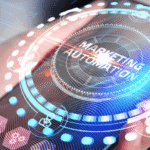Managing customer interactions across email, social media, websites, and mobile apps can quickly become stressful. That’s where multi-channel marketing automation helps. It uses tools like HubSpot or Marketo to connect and automate marketing across platforms. Instead of running each campaign separately, automation unifies them under one system.
The goal is simple: send the right message, to the right person, at the right time. Automation considers customer behavior, interests, and where they are in their journey. This creates a smoother and more personalized experience without manual effort for every step.
Why Multi-Channel Marketing Automation Matters
Today’s customers don’t stick to one channel. They check websites, browse social media, and open emails. If your messaging feels disconnected, they lose interest. Automation ensures all touchpoints connect seamlessly.
For example, a user might view your product on the website, then see a related ad on Instagram, and later get a follow-up email. When all these experiences link together, the customer feels understood. It builds trust and increases chances of conversion.
It also provides powerful insights. By tracking activities across different channels, businesses can see the full picture of customer behavior and improve strategies accordingly.
The Power of Personalized Messaging
One of the biggest strengths of automation is personalization at scale. Instead of sending generic emails or ads, you can deliver custom content. For example:
- Recommending products based on past purchases
- Sending a welcome sequence to new subscribers
- Offering discounts based on browsing activity
Such targeted communication boosts engagement. Customers respond better when they feel the brand understands them. Data collected from multiple channels makes personalization deeper, resulting in stronger connections and higher conversions.
The Growing Importance of Multi-Channel Marketing
Research shows 86% of marketers believe multi-channel strategies are more effective. The global multi-channel automation market is also growing rapidly, expected to hit billions in value in coming years.
This growth highlights how consumer behavior is changing. People expect a connected brand experience across platforms. Automation frees your team from repetitive tasks like manual emails or posts. This time can instead go into creative strategies, building relationships, and driving sales.
When used properly, multi-channel automation doesn’t just simplify tasks—it drives long-term business growth.
Building Your Strategic Automation Framework
Building a Framework
Effective automation is not about sending bulk messages. It’s about aligning your marketing with business goals. A proper framework ensures your campaigns are strategic, targeted, and results-driven.
Understanding Your Audience Across Platforms
Success begins with audience knowledge. Go beyond age or location. Learn where your audience spends time and what content they enjoy. For instance:
-
Instagram users may prefer visuals
-
LinkedIn users may prefer long-form insights
When you know their behavior on each channel, you can craft the right strategy for every platform.
Identifying Optimal Touchpoints and Crafting Cohesive Messaging
Next, find the best touchpoints. Look at website traffic, email open rates, or social media engagement. Use these insights to place your key messages where your audience listens most.
Your message must stay consistent everywhere. The tone may change (casual on Twitter, professional on LinkedIn), but the core brand message should remain the same. This creates harmony and trust.
Strategic Channel Selection and Timing Optimization
Not every channel works for every business. A B2B company may find LinkedIn more useful, while e-commerce may focus on Instagram and Facebook.
Timing also plays a key role. Scheduling messages when your audience is active increases engagement. Tools like Spur can help manage timing across WhatsApp, Facebook, and Instagram.
Content Adaptation and Maintaining Brand Voice
Each channel needs unique content. A tweet is not the same as a LinkedIn post or a blog. But your brand voice must remain consistent. This balance keeps messaging authentic while maximizing impact. Platforms like Spur simplify this by centralizing communication and keeping tone consistent across all touchpoints.
Essential Tools and Technologies That Actually Work
Key Features To Consider
When selecting a platform, look for:
- CRM integration to keep customer data unified
- AI-powered personalization
- Cross-channel data synchronization
- Strong behavioral tracking and orchestration
The right tool saves time and allows your team to focus on strategy rather than repetitive tasks.
Comparing Leading Platforms
Here’s a quick comparison of popular platforms:
| Platform | Multi-Channel Support | AI Features | Integrations | Best For |
|---|---|---|---|---|
| HubSpot | Email, Social, Web, Mobile, Chat | Content Optimization, Lead Scoring | Salesforce, Analytics | SMBs, B2B |
| Marketo | Email, Mobile, Web, Social, Ads | Lead Scoring, Personalization | Salesforce, Dynamics | Large Enterprises, B2B |
| Salesforce Mktg Cloud | Email, Mobile, Social, Web, Ads | Einstein AI Personalization | Sales & Service Cloud | Large Enterprises, B2C |
| ActiveCampaign | Email, Web, Social, SMS, Chat | Automation, Segmentation | Shopify, WordPress | SMBs, Ecommerce |
Choosing depends on your business size, industry, and marketing goals.
Avoiding Costly Mistakes
Many businesses fail because they rush implementation. To avoid mistakes:
- Define clear goals and customer journey first
- Ensure system integration to avoid data silos
- Implement in phases to reduce disruption
Proper planning ensures smooth adoption and better ROI.
Maximizing ROI Through Strategic Implementation
Calculating ROI and Justifying Budgets
Marketing automation saves both time and money. Less manual work means cost savings. Improved lead quality means higher revenue.
For every dollar spent, companies usually get back over $5 in returns. This shows the strong financial case for automation.
Key Performance Metrics for Long-Term Success
To measure success, focus on:
- Conversion rates
- Customer lifetime value (CLTV)
- Retention rate
These metrics show both short-term gains and long-term growth.
Attribution Modeling and Customer Journey Tracking
Use attribution models to see which channels drive the most conversions. Track customer journeys to understand behavior better. With this data, you can adjust campaigns to deliver maximum impact.
Implementation Best Practices For B2B Organizations
Nurturing Complex Sales Processes
B2B sales cycles involve multiple people and longer timelines. Automation can:
- Deliver targeted content
- Automate follow-ups
- Maintain consistent brand messaging
This ensures smoother journeys for decision-makers.
Engaging Multiple Decision-Makers
In B2B, one person rarely decides alone. Account-based marketing automation helps reach different stakeholders with tailored messages like LinkedIn connections, emails, or case studies.
Maintaining Personalized Communication at Scale
B2B automation allows personalization by segmenting audience groups based on role, company size, or industry. This ensures the CEO and the manager receive different but relevant content.
Lead Scoring and Sales Team Integration
Automation assigns scores to leads based on engagement. Integration with CRM ensures sales teams can focus on the most promising leads with accurate data.
Measuring Success and Optimizing Performance
Establishing Meaningful KPIs
Instead of tracking only clicks or likes, measure metrics like CLTV, conversion rates, or ROAS to align with business goals.
Creating Actionable Reporting Systems
Build dashboards to visualize KPIs clearly. Review them regularly to identify trends and make improvements.
Respecting Customer Privacy
Ensure compliance with data privacy laws. Be transparent about data collection and always give opt-out options.
Advanced Techniques for Optimization
Use A/B testing, cohort analysis, and industry benchmarking. These techniques uncover patterns and reveal areas that need improvement.
Key Takeaways
- Choose the right platform with CRM integration, AI features, and strong analytics
- Plan realistic timelines in phases: Planning → Setup → Testing → Launch
- Avoid mistakes like data silos or unclear goals
- Plan budgets carefully (platform, training, integration)
- Scale gradually by adding new channels, personalization, and team support
By following these steps, multi-channel marketing automation can transform your marketing. It builds trust, saves time, and drives real results.
Companies like DigiWexa show how automation can strengthen brand presence while making campaigns smarter and more efficient.







